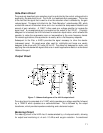14
currently mixing, I'm using both an 1176 and an LA2 on his voice, which is not unusual for
me.
"The 1176 absolutely adds a bright character to a sound, and you can set the attack so
it's got a nice bite to it. I usually use them on four to one, with quite a lot of gain reduction.
I like how variable the attack and release is; there's a sound on the attack and release
which I don't think you can get with any other compressor. I listen for how it affects the
vocal, and depending on the song I set the attack or release--faster attack if I want a bit
more bite. My preference is for the black face model, the 4000 series--I think the top end
is especially clean.
"The LA-2A is not as versatile, but it also has a sound that I really like. On certain voices
you can crank it heavily, to where you almost want to put a piece of tape over the meter
because there's so much gain reduction that you don't want anyone else to see it! I'm not
particularly into over-compression, but when you use it that way there's something about it
that just sounds really great. It does depend how it's set on the back, where there's a flat
control that can be set to roll off certain frequencies when you reduce more gain. If you
have a singer with an intensely piercing voice I find that compressor a good one,
incredibly useful. It makes things warmer, especially when you crank it, and for thinner
voices that can be just the ticket."
Allen Sides
Allen Sides has always been known for having golden ears when it comes to the sound of
equipment. The owner of Ocean Way Studios in Los Angeles and Nashville, he's also a
speaker designer and engineer who is especially respected for his work with live
musicians, including orchestra and string dates. Among his recent credits are work with the
Goo Goo Dolls, Alanis Morissette and Green Day. Sides brings his different perspectives
into play when he talks about using the 1176.
"The 1176 is standard equipment for my sessions. I just used them last night, as a matter of
fact, on a project for singer Lisa Bonet that Rob Cavallo was producing at Ocean Way.
We were recording drums and I used them on the left/right overheads as effects limiters.
It's something I learned from (engineer) Don Landy, who worked with Randy Newman a
lot. I mult the left and right overheads and bring them back on the console, then insert a
pair of 1176s into a pair of the mults. Push in 20 to one and four to one simultaneously
and it puts the unit into overdrive creating a very impressive sound."
Murray Allen
Murray Allen is a veteran engineer and Director of Post Production for the San Franciso
Bay Area company Electronic Arts. He has a fascination for gear both old and new and
he explains why he thinks the 1176 has been so popular for so long. "It has a unique
sound to it that people like, it's very easy to operate, and it does a great job. You have just
two controls relative to the ratio of compression. You have input and output and you have
attack and release. That's all there is. It's still my favorite limiter for Fender basses and
string basses, because you don't know it's working. It doesn't change the way the bass
sounds, it just keeps the level at a more controllable place.


















